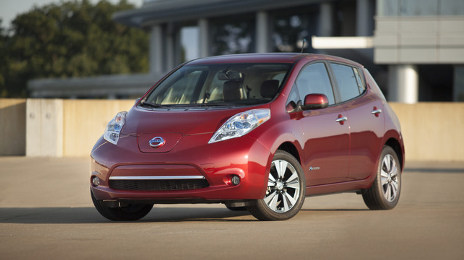Rapid EV depreciation poses dilemma for industry, dealers

According to NADA UCG data, trade-in values for the 2013 Nissan Leaf are 30 percent lower today than last year.
Numerous reports highlighting the alarming depreciation rate of electric vehicles have been surfacing, and this trend could be a challenging one for the industry.
In fact, many of the 2012 model EVs now cost less than their gas counterparts — surprising, after new premiums were so steep just a few years ago.
And Larry Dixon, senior manager of market intelligence at NADA Used Car Guide and speaker at the upcoming Used Car Week conferences, touched on this very topic in a recent Used Car & Truck Blog post.
Dixon participated in a panel at the 8th annual Electric Vehicle Roadmap conference in Portland, Ore., and many of the challenges facing EVs were top-of-mind at the event, one being very poor residuals.
“Excluding those produced by Tesla, electric vehicles (no matter the form) have had a hard go of it. Higher upfront costs, range and infrastructure concerns, technology apprehension, and lower gas prices have dogged EV demand,” Dixon said in the blog post.
And it’s not just used EVs and alt-fuel vehicles that are suffering. According to NADA data, new plug-in hybrid sales were down by 34 percent through June, and sales for the the Chevy Volt, Nissan Leaf, and Toyota Prius PEV fell by 35 percent, 23 percent and 69 percent, respectively, over the first half of the year.
“Plug-in electric sales were up by 30 percent, however; the lift was caused by new model launches, rather than improving demand,” Dixon added.
But the used EV market is taking an even bigger hit. Though used EV prices are dropping considerably, seemingly making them a good buy for the budget-conscious, fear of long-term costs keeps many buyers away from the plug-in options.
“Used-vehicle buyers tend to lean more toward frugality than their new vehicle counterparts. As such, concerns over upfront cost and long-term durability are more amplified,” Dixon said. “’How much will the battery degrade over time? How will this impact driving distance? What happens, and what will it cost, if the battery needs to be replaced?’ are just a few of the unknowns eating into used EV demand.”
Dixon also pointed out a two other factors that are contributing to downward pressure on used EV prices:
- Very low new vehicle lease programs for EVs
- New EV tax credits, unavailable to the used buyer
Offering a current market example, according to NADA UCG data, trade-in values for the 2013 Nissan Leaf are 30 percent lower today than last year.
Dixon offered this stat for comparison: Trade-in values for 2013 gas powered compact and mid-size cars are down by just 12 percent.
“Abysmal depreciation is a major problem. It’s not only a poor reflection on the technology, it puts EVs at a cost-of-ownership disadvantage relative to internal combustion engine (ICE) vehicles,” said Dixon. “It also increases the amount of money automakers have to put toward lease-related expenses, which is a big deal given that leasing accounts for 55 percent of all new EV deliveries.”
And even though many used buyers may be deterred by concern over battery life and other cost-of-ownership factors, low prices on low-mileage, late-model EVs do “make them incredible values,” Dixon pointed out.
“Even though we fully expect Leaf deprecation to remain high moving forward (not to pick on the Leaf, we expect this for most EVs), prices are now low enough that net energy savings and ― theoretically ― lower routine maintenance costs make the Leaf a competitive alternative to the Versa and other similar gas-powered cars,” Dixon continued.
But to really capitalize on used EV sales, dealers will need to be able to convince consumers that used EVs and their batteries can stand the test of time.
“Consumers have experienced gas-powered cars in a hands-on fashion for over a century, but have only been exposed to plug-in electric vehicles for a handful of years,” Dixon said. “As such, an extraordinary amount of time needs to be spent marketing not only the benefits of the products themselves, but also touting durability milestones as time passes, which includes battery density, maintenance costs and more.”
Auto Remarketing has been following this story closely as many EVs start entering the late-model used market.
Earlier this month, Black Book released data that showed most 2012-model EVs have depreciated to such a level that premiums over their gas counterparts no longer exist.
According to Black Book, in some instances, consumers can shell out up to $20,000 more for a new electric version of a vehicle than they would for the sister gas model.
That said, three years down the road, Black Book pointed out, EVs could easily be priced $900 below their gas counterparts, showing rapid declines in price.
And a recent Yahoo Autos blog report asserted that in light of dropping residuals for used EVs, they could be a could sell for the budget-conscious customer — that is, if they can be convinced of the longevity and dependency of such a vehicle.
When EVs first hit the market, federal tax credits and significant manufacturer incentives made these models an enticing buy for many fuel-conscious auto shoppers. But as blog post author Steven Lang pointed out, “there are no similar incentives for buying used EVs,” and demand hasn’t lived up to hype, putting extreme downward pressure on used prices for some of these models. And with oil prices still far below average, fuel economy isn’t currently much of an incentive either.”

 View The Latest Edition
View The Latest Edition

